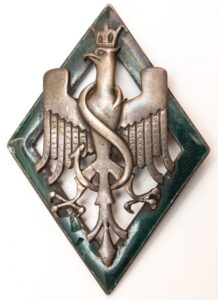 “Former soldiers of the 5th Division of the Polish Army in eastern Russia and Siberia often think back to those moments sixteen years ago, when in December and January at the turn of 1919/20, in 30 or 40 degrees of frost, in Siberia, on the enormous 800km route between the city of Novo-Nikolaevsk (now Novosibirsk) and Klukvyennaya station near Krasnoyarsk, the last act of the drama of the Polish 5th Siberian Rifle Division, rightly referred to in our military history as the Last Legions, took place”. These are the words of Stefan Wojstomski, a veteran of the Polish 5th Siberian Rifle Division, more commonly known as the 5th Siberian Division. Volunteer Polish units in Siberia began to organise as early as the turn of 1918. Alongside the Russian counter-revolutionaries, the so-called whites (Polish: biali), and the Entente forces, they stood against the Bolshevik troops. Numbering several thousand soldiers, the 5th Siberian Division, under the command of Colonel Kazimierz Rumsza, was in charge of protecting a section of the Trans-Siberian Railway and then securing the retreat of the “white” troops by slowing down the Bolshevik offensive.
“Former soldiers of the 5th Division of the Polish Army in eastern Russia and Siberia often think back to those moments sixteen years ago, when in December and January at the turn of 1919/20, in 30 or 40 degrees of frost, in Siberia, on the enormous 800km route between the city of Novo-Nikolaevsk (now Novosibirsk) and Klukvyennaya station near Krasnoyarsk, the last act of the drama of the Polish 5th Siberian Rifle Division, rightly referred to in our military history as the Last Legions, took place”. These are the words of Stefan Wojstomski, a veteran of the Polish 5th Siberian Rifle Division, more commonly known as the 5th Siberian Division. Volunteer Polish units in Siberia began to organise as early as the turn of 1918. Alongside the Russian counter-revolutionaries, the so-called whites (Polish: biali), and the Entente forces, they stood against the Bolshevik troops. Numbering several thousand soldiers, the 5th Siberian Division, under the command of Colonel Kazimierz Rumsza, was in charge of protecting a section of the Trans-Siberian Railway and then securing the retreat of the “white” troops by slowing down the Bolshevik offensive.
Surrounded by Bolsheviks, the Polish soldiers surrendered on 10 January 1920. Most of the soldiers were sent to camps and prisons. They did not reach Poland until two years later, after the end of the Polish-Bolshevik war. The others tried to break out of their captivity. Some of them died, but nearly a thousand made their way to Irkutsk and then to Japan, from where they reached Gdańsk in July 1920 on a ship provided by the Polish government. Just a month later, in the ranks of the Siberian Division, they were defending Poland against the Bolshevik onslaught… “The 5th Division of the Polish Army […] did not secure its existence but it saved its honour and shone as a model of chivalrous virtue”, Wojstomski wrote. “This is also why the soldiers who were lucky enough to serve in the Polish 5th Siberian Rifle Division wear their badge with pride.”
Photo: Polish 5th Siberian Rifle Division badge. From the Sybir Memorial Museum collection



